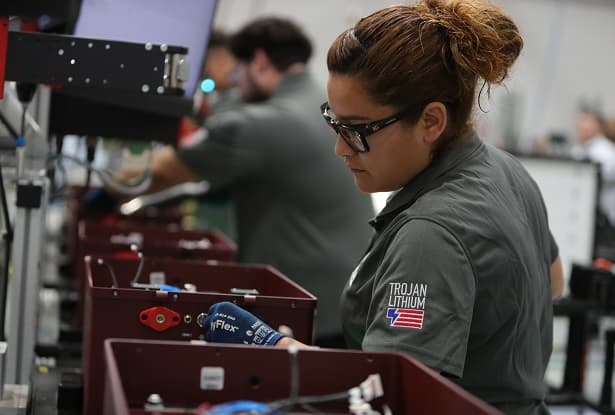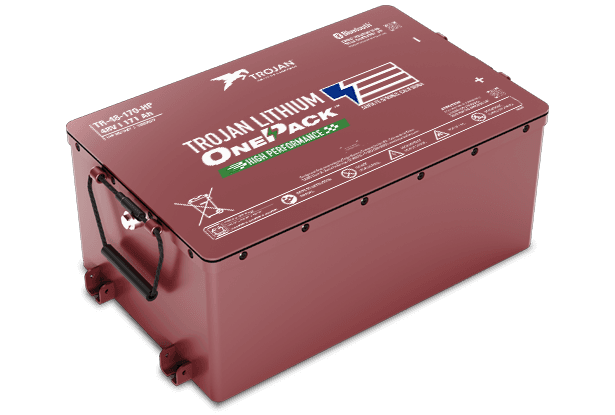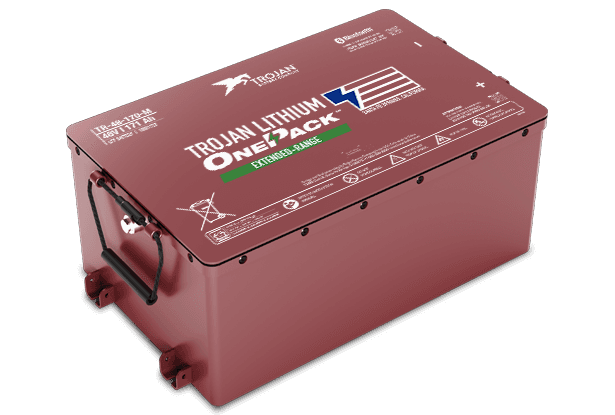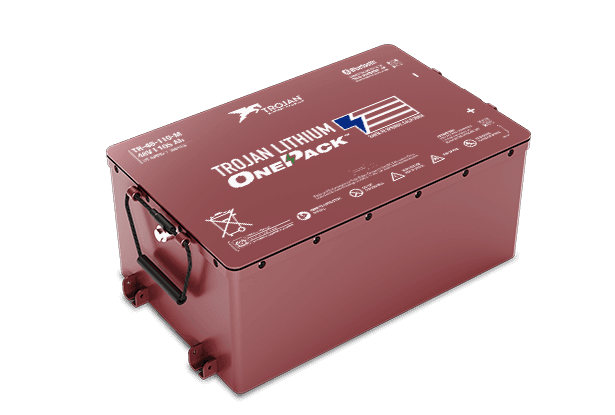
Find Answers
Find answers to common questions about lithium-ion batteries, including:
Performance
Installation
Maintenance
Charging
Storage
Shipping
Need an answer you don't see here? Find and contact an Authorized Trojan Lithium-Ion Battery Dealer.
General lithium-ion battery questions
Lithium-ion batteries are made up of multiple small cells connected together to provide the voltage and current needed for the application. The Battery Management System or BMS is responsible for keeping these cells working in unison so that they are charged and discharged correctly. Lithium-ion cells are more sensitive to overcharge and undercharge conditions than many other battery chemistries. The BMS monitors the charge and discharge of the battery to ensure the battery operates safely.
Trojan developed a BMS for our lithium batteries that is able to monitor individual cells, internal battery temperatures, state of charge, state of health plus charging voltage and current to provide the safest and most reliable operation possible.
Trojan lithium batteries use Lithium-Iron-Phosphate cells. For most applications, lithium iron phosphate—or LiFePO4—is a safer chemistry than comparable lithium-ion batteries that use Nickel Manganese Cobalt or NMC-based chemistry cells.
There is no date code on Trojan Lithium-Ion Batteries. The manufacturing date is marked on the sticker with the serial number on the side of the battery.
Many factors will go into choosing the correct setup for your unique cart. Factors that must be considered are:
• Motor controller size
• Drive motor size
• Oversized tires or aftermarket gearing
• Accessories using battery power (lights, radios, etc.)
Authorized Trojan Lithium-Ion Dealers can assist you in determining the best configuration for your needs.
Lithium-ion battery performance
Generally, the battery performance is directly related to temperature. Charging and discharging minimum and maximum temperatures are listed below. There are additional charging temperature constraints described in the Trojan OnePack User’s Guide.
Trojan Lithium-Ion Batteries will disable both charge and discharge functions when the internal battery temperature exceeds 140°F (60°C) or falls below -4°F (-20°C).
If discharge functions are disabled, they will be restored automatically when the internal battery temperature is between 14°F (-10°C) and 131°F (55°C).
Trojan OnePack lithium batteries have an expected life of at least ten years or 4,000 cycles to 70% depth of discharge. Expected life is per manufacturer guidelines.
Yes, all Trojan Lithium OnePack™ family batteries [OnePack, OnePack Extended Range (XR) and OnePack High Performance (HP)] are compatible and supported in the Navitas Dashboard App. Simply select “Trojan OnePack” from the battery menu during setup for optimal performance.
Lithium-ion battery safety
The Trojan Lithium-Ion Battery is a sealed battery, so there is no risk of contact with the internal components under normal operation. Eighty percent (80%) of the cells are solid and only two percent (2%) of the contents are corrosive. Refer to the Safety Datasheet: Lithium-ion Battery Safety Datasheet for OnePack for a breakdown of the components within the battery.
Standard Personal Protective Equipment for installing a golf cart battery should also be used when installing Trojan lithium batteries. This includes safety glasses, safety toe shoes, and cut-resistant gloves.
Insulated tools should always be used when working around batteries.
Maintenance of lithium-ion batteries
Lithium-ion batteries are sealed and do not accelerate corrosion. Some environmental conditions such as water exposure, saltwater mist or other may still cause corrosion on copper cable lugs, cables or non-stainless steel hardware. It is recommended to regularly inspect the terminals on the battery and clean them as needed.
Authorized Trojan Lithium-Ion Dealers have Trojan specific cables and software that allow them to interface with the BMS and read alarm and event history as well as view details regarding the battery's current condition.
Connecting to the BMS requires a Trojan Service Cable kit, which includes a USB-to-CAN adapter, two (2) CAN Terminators, and an M8-to-DB9 adapter.
The terminal should be torqued to between eighty (80) and ninety (90) inch-pounds using a calibrated torque wrench.
When the button on top of the battery is pressed, a number of Blue LEDs indicate the state of charge from 0-25% (1 LED), 26-50% (2 LEDs), 51-75% (3 LEDs) and 76-100% (4 LEDs).
The battery has six LEDs that help the user determine the battery's condition. When the button on top of the battery is pressed, a number of Blue LEDs indicate the state of charge from 0-25% (1 LED) 26-50% (2 LEDs) 51-75% (3 LEDs) and 76-100% (4 LEDs). In addition, either a red or green LED will also illuminate. A green LED indicates that the battery is operating normally and no faults are present. A red LED indicates there is a fault.
If a fault is present, users can gather an indication of the fault by the present state of the battery. Faults are typically caused by one of four conditions:
• High Temperature (While Charging or Driving)
• Low Temperature (While Charging or Driving)
• High Current (While Driving or Charging)
• Low Voltage (While Driving)
Maintenance free indicates that the battery does not require watering, equalize or maintenance charges, or frequent cleaning of the terminals. It is still recommended that a visual inspection is performed on the battery on a regular basis.
Follow storage and maintenance for all Trojan Batteries according to the User's Guide and warranty.
The battery has six LEDs that will help the user determine the battery's condition. When the button on top of the battery is pressed, a number of Blue LEDs indicate the state of charge from 0-25% (1 LED), 26-50% (2 LEDs), 51-75% (3 LEDs) and 76-100% (4 LEDs). In addition, either a red or green LED will also illuminate. A green LED indicates that the battery is operating normally and no faults are present. A red LED indicates there is a fault.
A short circuit fault occurs when the battery is powered on and a direct conductive path is created between the positive and negative terminals. This fault can also be activated if more than 600A are passed through the battery from an external source.
When the short circuit fault is active, it will not automatically reset. The user must verify that the cause of the fault has been corrected and then perform the same procedure used to bring the battery out of storage mode to clear the short circuit fault.
Charging lithium-ion batteries
Trojan Lithium-Ion Batteries will temporarily disable charging function at temperatures above 113°F (45°C) or below 32°F (0°C). At temperatures below 68°F (20°C), charging current is automatically limited. Refer to the user guide for charging current limits.
If charging functions are disabled due to temperature, they will be restored automatically when temperature is within range.
Storage and shipping of lithium-ion batteries
Trojan lithium-ion batteries arrive in approved packaging that can be saved for future use.
To ship a Trojan lithium battery, the battery must be packaged in a UN Rated and marked 4G Fiberboard Box with Y25 Weight. It must be secured and prevented from moving freely within the box, using anti-static bubble wrap or foam.
The box must be labeled as DOT Class 9 with Lithium Ion Batteries, UN3480 displayed on the outside of the box. For air transport, a Cargo Aircraft Only label must be present.
Download: Lithium-Ion Battery Repacking Instructions
The Trojan Lithium-Ion Battery is classified as UN3480 and as such must be at or below fifty percent (50%) state of charge when shipped via land or sea and below thirty percent (30%) state of charge when shipped via air.
Yes, as long as both battery types are properly packaged and labeled, they can be shipped on the same vehicle.
Wherever possible, putting lithium-ion and lead-acid batteries on the same pallet should be avoided. If it cannot be avoided, the pallet must be clearly labeled as containing both.
Lithium-ion batteries must be individually packed and labeled on the pallet as well.
A battery subject to UN3480, like Trojan lithium-ion batteries, cannot be transported on a passenger aircraft. As long as it is correctly prepared, packaged and labeled, no other restrictions apply. Refer to the User's Guide for details on preparation and packing.
Storage requirements for Trojan Lithium-Ion Batteries are the same as for other battery types. They should be stored in a clean, cool and dry environment and protected from direct sunlight.
For batteries being stored in a warehouse, it is recommended that they be left in the original packaging for protection and so they can be shipped easily.
The Trojan Lithium-Ion Battery can be stored alongside lead-acid batteries. However, it is recommended that they be clearly labeled as lithium-ion to prevent misidentification.
Follow storage and maintenance according to the Trojan OnePack Lithium-Ion User's Guide and warranty.
The Trojan Lithium-Ion Battery is designed to be stored for up to six months when placed into storage mode at a state of charge above twenty-five percent (25%).
Temperatures exceeding 77ºF (25ºC) or below 32ºF (0ºC) can reduce the available storage time.
A BMS integrated into a battery pack does draw a small amount of current from the batteries to continue running. Trojan Lithium-Ion Batteries feature a sleep/storage mode which reduces this draw by 5x.
This allows the battery to be stored for up to six months as long as it is placed into storage mode with more than twenty-five percent (25%) state of charge.
If the battery is not put into storage mode, it will automatically enter storage mode after thirty (30) days of inactivity.
Press and hold the button on the top of the battery. If it is already in storage mode, the LEDs will illuminate one at a time until they are all illuminated. Continue to hold the button for two (2) more seconds and then release. Wait ten (10) seconds and confirm the battery has powered on by pressing the button for one (1) second to show a Red or Green LED indicating the battery status and a combination blue LEDs indicating the state of charge.
If the battery is powered on, the LEDs will all illuminate and then turn off one by one. Continue to hold the button for an additional two seconds and then release. Wait ten (10) seconds and press the power button briefly, only a blue LED will flash to indicate that the battery is in storage mode.
Accessories for lithium-ion batteries
Yes, Trojan offers an external Battery Charge Indicator separately from the battery to provide end users with the remaining State of Charge % of the batteries in the vehicle. When the display reaches 20%, it will show a low battery notification to let the user know that the battery is approaching its total usable capacity and should be recharged soon. The display will also show if any faults or alarms are present on the batteries.
Authorized Trojan Lithium-ion Dealers can perform the installation of the external gauge and all necessary cable connections.
Yes, all Trojan Lithium OnePack™ family batteries [OnePack, OnePack Extended Range (XR) and OnePack High Performance (HP)] are compatible and supported in the Navitas Dashboard App. Simply select “Trojan OnePack” from the battery menu during setup for optimal performance.
Purchasing
Trojan GC2 lithium batteries were discontinued as of November 15, 2025. For more information, visit the Discontinued Product page for the GC2 series.
Learn more about Trojan's 48V OnePack Lithium Battery Packs.

Lithium Battery Safety Series
Discover what goes into making and choosing safer lithium batteries in this series from Trojan experts.
Learn more about lithium battery technology; click the button below.
Trojan Lithium OnePack Single Packs
Lithium batteries for golf carts, UTVs, LSVs, and other equipment
Find the right battery for your equipment with the Battery Finder
Use the Battery Finder online tool to choose the right deep cycle battery for your exact make and model.
You'll find the ideal power source for your golf cart, floor scrubber, aerial lift, pallet jack, or other vehicles or equipment.




